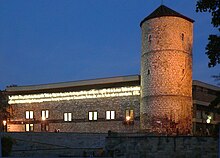Zeughaus am Hohen Ufer

The armory at the Hohen Ufer in Hannover was the oldest of the territory of the Hanoverian old town on the construction of the line lock following state buildings . The ducal armory, built by the middle of the 17th century for Georg Wilhelm , Duke of Braunschweig-Lüneburg , included a remnant of the former city fortifications of Hanover . The massive outer walls that have been preserved were later incorporated into the new building of the Hannover Historical Museum - with heavily modified openings .
history
After the sovereign , Duke Georg von Calenberg, had designated the city of Hanover as his residence in 1636 in the middle of the Thirty Years War , the magistrate gave him the property north of the Begin Tower in 1639 . Adjacent to this city tower, the ducal master craftsman Welling erected a simple utility building from 1643 to 1649 with almost no architectural decoration : he had two massive , unplastered floors built from the limestone broken on the Lindener Berg , above one made of half-timbered , with a high roof with porticoes was covered. All storeys were originally divided into three aisles with wooden supports .
For a long time, the arsenal served as a warehouse as well as a workshop for military equipment of the Welfs .
At the time of the Kingdom of Hanover , the function of the aging armory was replaced by the new building of the armory on Waterlooplatz . As a result, the older building became the property of the city of Hanover.

Postcard No. 229 from Georg Kugelmann

Colored postcard No. 1319 B of Wilhelm Hoffmann AG
During the founding of the German Empire in 1887, the old armory was shortened from around 57 meters to a length of 36 meters in order to enable a breakthrough in the Roßmühle street, which had previously been a dead end . For this purpose, the north wall of the armory was rebuilt and the coat of arms of Duke Georg Wilhelm , dated 1649 and presumably by the sculptor Peter Köster , was inserted into it.
In the northern part of the former armory, the municipal loan office soon started its work.
By the air raids on Hannover during the Second World War and the old armory was by aerial bombs of the Allies badly damaged.
In the post-war period , the massive outer walls of the armory - but now with heavily modified openings - were incorporated into the new building of the Historical Museum and today also forms the museum's largest exhibition space.
See also
literature
- Arnold Nöldeke : Ducal armory. In: Die Kunstdenkmale der Stadt Hannover , Vol. 1, H. 2, Teil 1, Monuments of the "old" city area Hannover , Hannover: Self-published by the provincial administration, Schulzes bookstore, 1932 (Neudruck Verlag Wenner, Osnabrück 1979, ISBN 3-87898- 151-1 ), pp. 396-402
- Gerd Weiß: The fortification of the old town. In: Monument topography of the Federal Republic of Germany , architectural monuments in Lower Saxony, City of Hanover, part 1, vol. 10.1, ed. by Hans-Herbert Möller, Lower Saxony State Administration Office - publications by the Institute for Monument Preservation , Friedr. Vieweg & Sohn, Braunschweig / Wiesbaden 1983, ISBN 3-528-06203-7 , p. 51f .; as well as: middle of the addendum to volume 10.2, list of architectural monuments according to § 4 ( NDSchG ) (excluding architectural monuments of the archaeological monument preservation) / Status: July 1, 1985 / City of Hanover , p. 3ff.
Web links
Individual evidence
- ^ Helmut Knocke , Hugo Thielen : Pferdestraße 6 , in Dirk Böttcher , Klaus Mlynek (ed.): Hannover. Kunst- und Kultur-Lexikon , new edition, 4th, updated and expanded edition, zu Klampen, Springe 2007, ISBN 978-3-934920-53-8 , p. 178ff .; here: p. 179
- ^ Klaus Mlynek : Residenzrezess (contract). In: Klaus Mlynek, Waldemar R. Röhrbein (eds.) U. a .: City Lexicon Hanover . From the beginning to the present. Schlütersche, Hannover 2009, ISBN 978-3-89993-662-9 , p. 521.
- ↑ a b c d e f g Helmut Knocke: Zeughaus am Hohen Ufer. In: Stadtlexikon Hannover , p. 689
Coordinates: 52 ° 22 ′ 19.1 ″ N , 9 ° 43 ′ 52.8 ″ E

